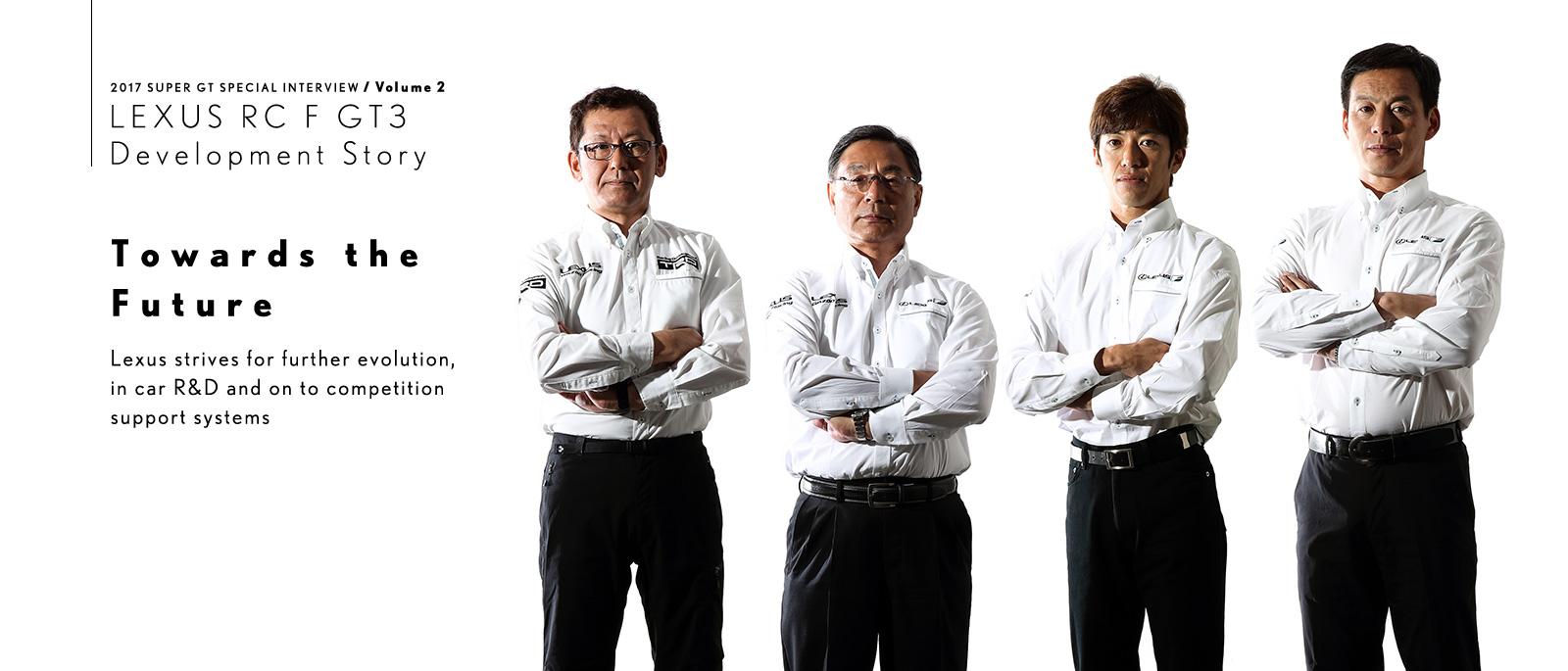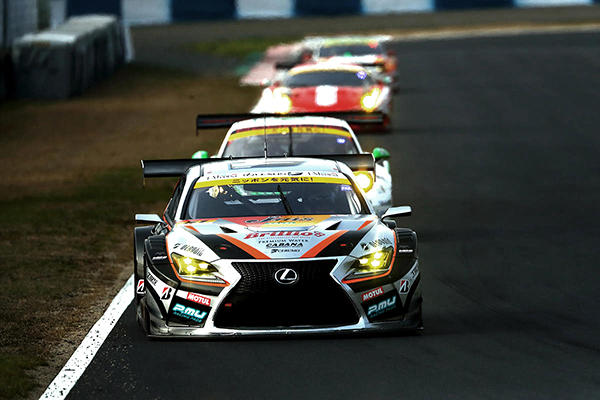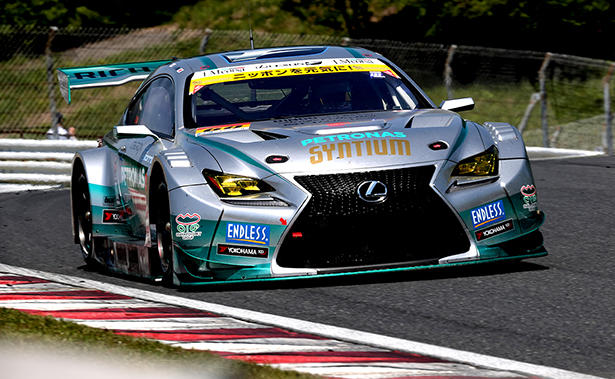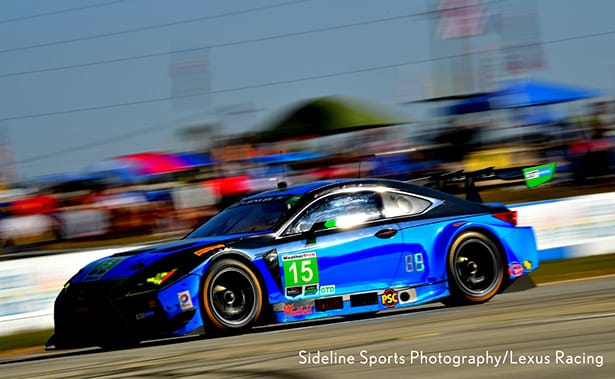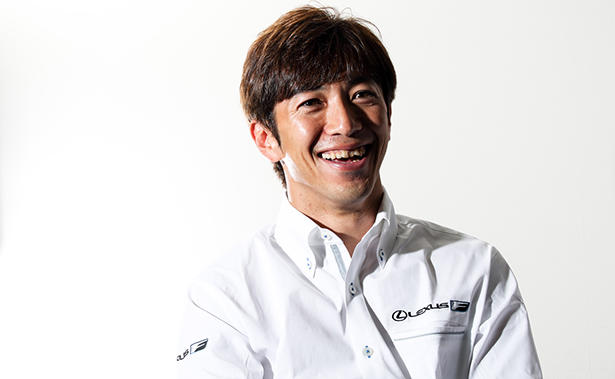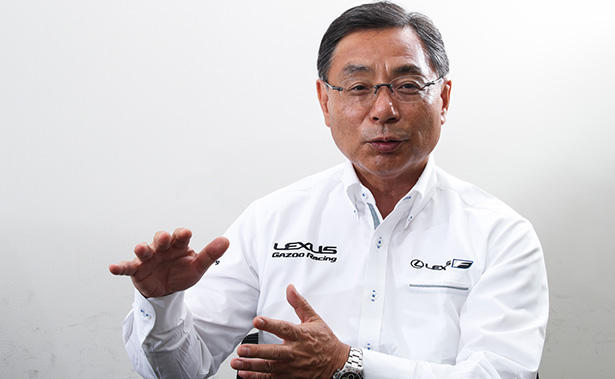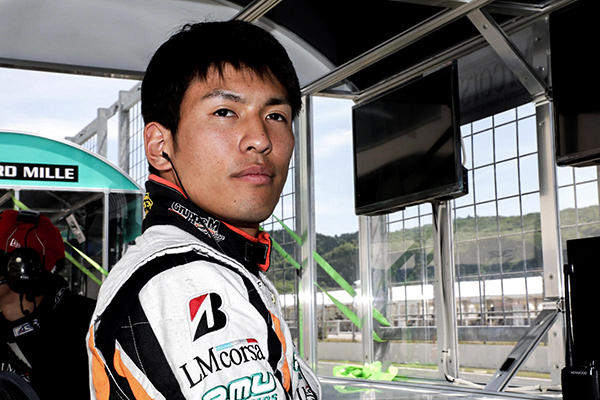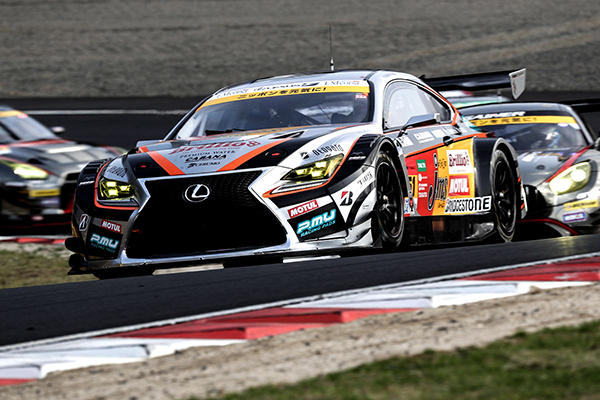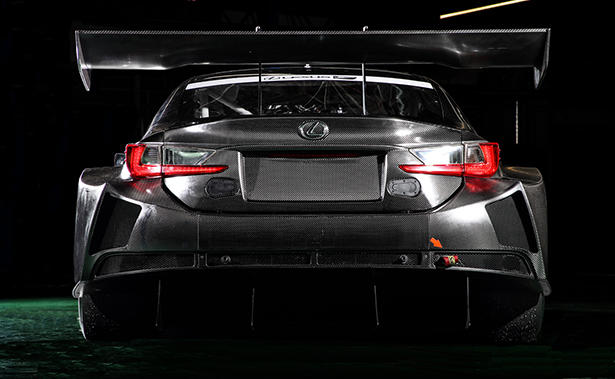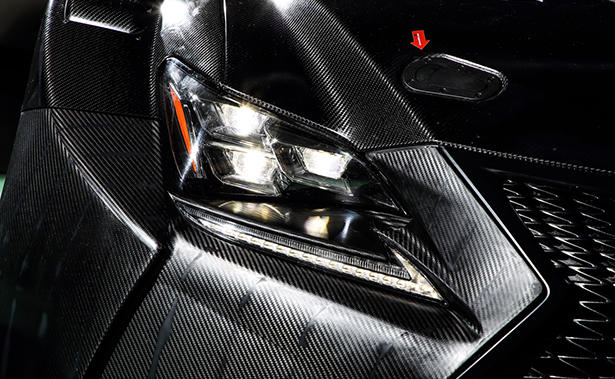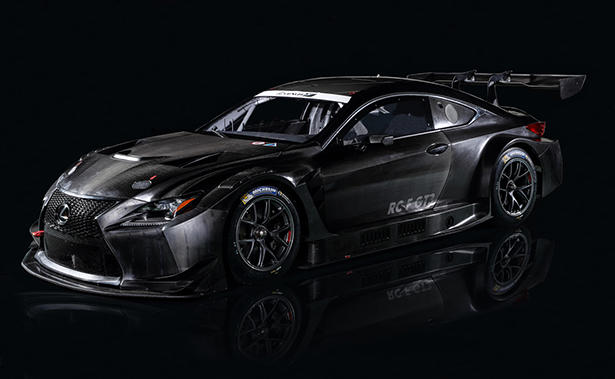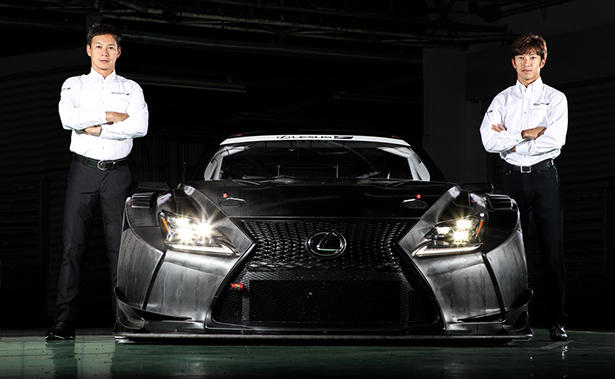Re-development of the 2017 model LEXUS RC F GT3 began from almost zero.
The aim was not just to develop a "competitive racing car capable of winning races," but as we see, a lot of measures were also taken to make sure it was a customer racing car that could compete as a FIA GT3 car on circuits around the world.
We also asked four keypersons that worked on the Lexus FIA GT3 project about it and how its development will continue in the future.
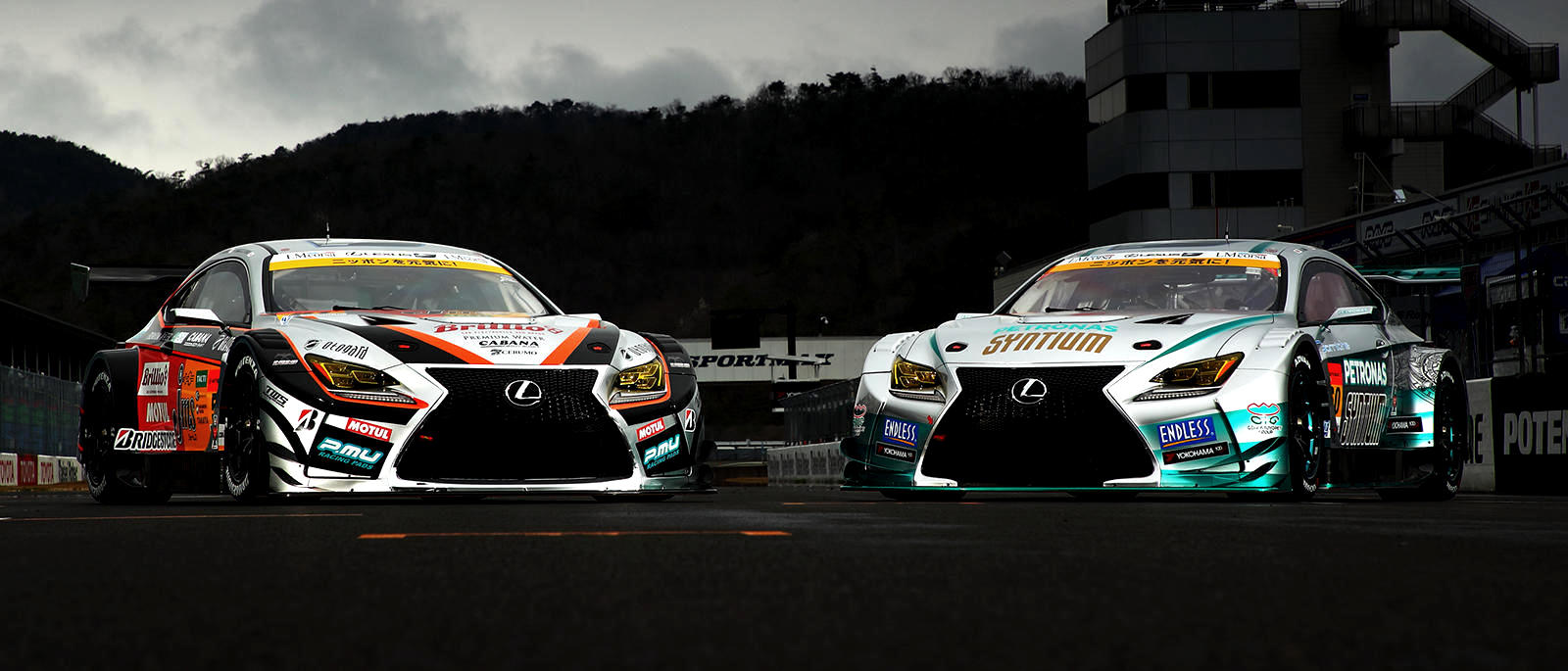
-- We are told thatyour key word for developing the 2017 model LEXUS RC F GT3 as a winning machine was "simplicity." We also know that you had to further reduce the weight of the 2015 model, but inspecific terms, what did that involve?
Kazuki Yuasa: Since it is basically a racing car that adopts the monocoque body of the production model, it is difficult to further reduce the weight of the chassis parts. So, in addition to re-designing the suspension, etc., it became a painstaking process of finding and removing unnecessary parts in the process of strengthening the structural elements.
Akira Iida: Reducing weight produces immediate results. In the development of the 2017 model, I could feel right away that it had gotten lighter the first time I drove. But even more than that I remember being surprised at how much firmer the body felt.
-- During the development, I believe that basically all of the FIA GT3 cars were your rival, but was there any maker whose car particularly concerned you?
Iida: One of the things I thought was that the so-called supercars, like the Lamborghinis and the Ferraris, had an advantage in that the height of the base cars was lower than others to begin with. However, there was no use in worrying about things that can't be helped. So, with the RC F GT3 as well we were able to change the engine to a dry-sump spec to lower its mounting position and thus lower the car's center of gravity.
Yuji Tachikawa: All of the FIA GT3 cars are our rivals. Because FIA GT3 cars are also competing in SUPER GT (in GT300 class). And since many of the GT300 course records for the circuits in Japan that we test on are held by FIA GT3 cars, those records become our initial targets.
Iida: When we speak about "speed," the FIA GT3 cars are not ones that are built just for short bursts of speed. The world standard for FIA GT3 cars is that they be both fast and tough. To achieve both of those qualities it is important that they be "simple" in design. We have opportunities to see FIA GT3 cars at races and the like where they are our rivals, and when we do, I am always reminded of the importance of being "simple" in structure, with regard to maintenance and setting changes. In the development work, we make sure to give our opinions in that regard.
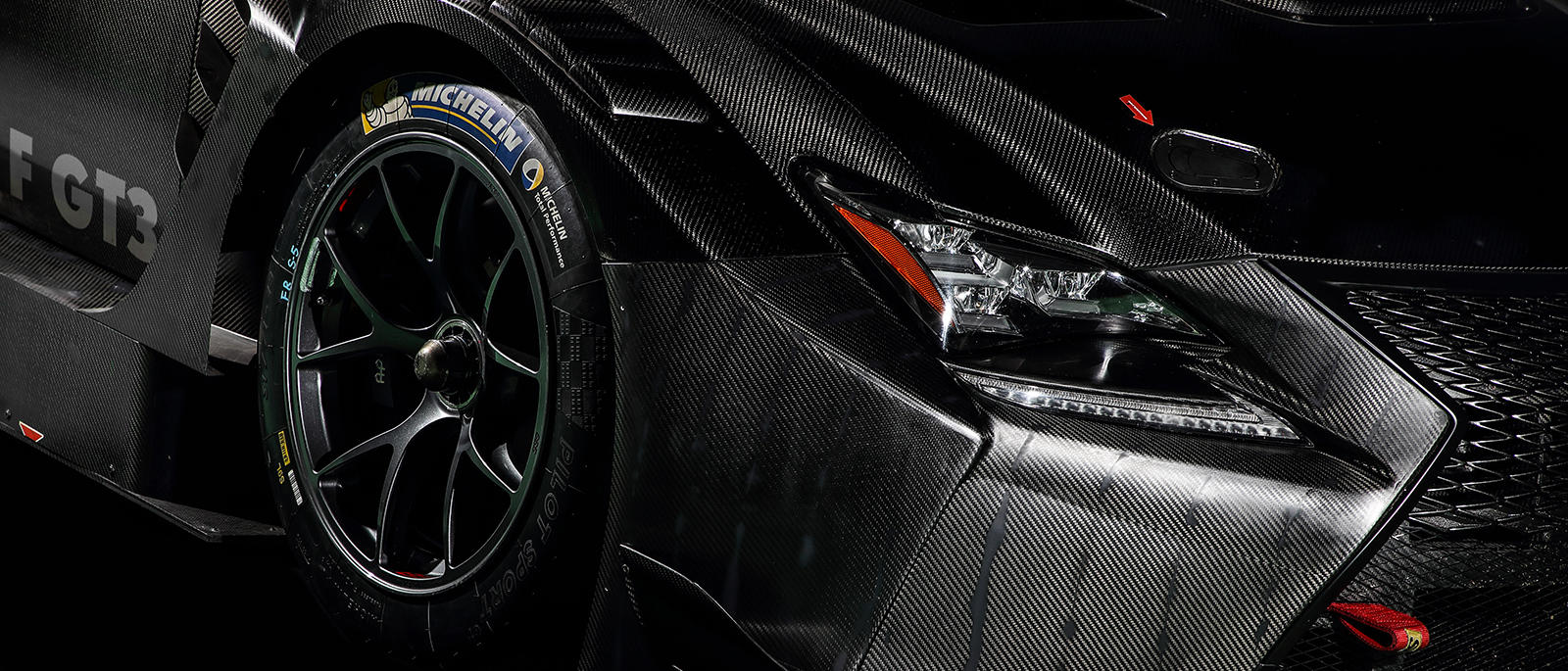
-- Hopefully the LEXUS RC F GT3 will be used globally, so are you doing tests with that in mind?
Yuasa: Since we are thinking that the car will be delivered to teams around the world, it has to be a car that can adjust to a wide range of environments. For that reason, in the development stages we bring in tires from countries around the world to conduct tests with.So, it is not a car that only performs well with one type of tire. And although the track surfaces of circuits in Japan tend to be well cared for, overseas you will encounter tracks that have potholes and the like, so we have to build in qualities with concern for those kinds of differences in road surface. Also, in the IMSA series in the U.S. we will sometimes have to compete on banked oval courses. The effects on the cars with this kind of track are of a completely different dimension. So, we have to be aware of that from the beginning too.
Iida: With the RC F GT3, an important development theme is that the car provides stable performance at a very high level regardless of the environment and conditions. Naturally, another big precondition is that the drivers who will be using the car also will be ones with different levels of racing skills. That means we have to build a car that will be fast no matter who is driving it.
Tachikawa:We believe that a car that can win in races that are to some degree "long distance races" will basically be a car that is easy to drive. That is because, in the end, that kind of "ease of use" contributes to stable high-speed performance. What becomes important in that respect is the base performance as a racing car. For that reason, during the development stage, there were times when we tested the machine while turning off all the electronic control systems. That process of building in good performance in that basic unassisted condition is an element that contributes to this year's RC F GT3's performance.
--When speaking of basic performance, brings up questions about the performance potential of the production model RC F as well. Does that have a big effect?
Iida:It does, of course. Among the makers of FIA GT3 cars, there are some who build their production models on the premise that they will become the base cars for their racing cars. So, with Lexus, where passenger cars are the main product, from there they build their sports car model and then we develop that further into a racing car. Thinking from that perspective, it is not necessarily an advantageous position to work from. Buth through the process of feeding back information and knowhow we gain from our racing car development into Lexus production models, we hope that the result will be an overall rise in the basic performance of all Lexus cars.
Tachikawa: With a technical regulation like that for FIA GT3 cars, the performance of the base production model certainly becomes an important factor.
-- Considering that, it is easy to understand why races for FIA GT3 cars have become popular around the world, because winning those races proves that the potential of the base production models is also very high. As development drivers, how did the two of you feel when, as soon as May, the 2017 model RC F GT3 car No. 51 of the JMS P.MU LMcorsa team won the second round of the SUPER GT series at Fuji Speedway?
Tachikawa: Of course, we were glad that the car we helped develop won (laughs). In that race, I was also able to win (in the GT500 class), so it was a double (two class) win for Lexus. But, during the race, I was of course concentrating on the GT500 race. It wasn't until after the race that I realized it had been a double win. I didn't realize it was a double win until after I had parked my LC500 car in front of the podium, and then the (GT300 race winner) RC F GT3 pulled up alongside it.
Iida:I was only half as happy, because my car (the No. 60 SYNTIUM LMcorsa RC F GT3) had not won that day. So, half of me was disappointed (grimace). Of course, you never know what is going to happen in racing, but I had a strong determination that the next time it was going to be our team that won.
--Next, would you tell us what you concentrated on in the development of the LEXUS RC F GT3 knowing that it would be a car driven by amateur drivers around the world? Also, what points did you focus on to differentiate the car from those of the other makers knowing that it would be used under a regulation that used BoP (balance of performance) to equalize the performance with that of all the rival makes?
Yuasa: The important area of performance to differentiate the car from the rivals is aerodynamics. There is a regulation for aerodynamic performance in straight-line running for FIA GT3 cars. For that reason, while meeting the requirements of the regulation, we implemented measures to ensure that the aerodynamic performance would change only gently and smoothly as braking and cornering had their effects of the car's attitude. Thanks to those measures, I think it has become a very easy car to drive.
Iida: Elevating the levels of performance in the car's basic functions of "running, turning and stopping" is certainly the most important mission.The next is making it a car that feels easy to drive. Drivers who purchase a FIA GT3 car (since they have the financial means) will quickly buy a new one if they feel that the model they initially bought is no good. So, we believe that we have to build a car that will satisfy such severe, highly selective customers.
Keizo Takahashi: When it comes to FIA GT3 cars, which are essentially production cars, we are very much aware of the fact that, besides the car itself, it is very important that we provide a complete system for delivery of parts, etc., and support services. Developing the car is only half the job, and the other half is having in place the services and systems that enable the customers enjoy the car and competing with it to their heart's content. We are continuing to work to be prepared to provide a full range of customer services that build customer trust and satisfaction with the Lexus brand.
--Hearing all this, we can't help but look forward with anticipation to the new model scheduled for release in 2020.
Yuasa: Currently, with the RC F GT3 being used in Japan, the U.S. and Europe, while development is going on in Japan, we are also receiving feedback from Europe and the U.S., and as we clear all the new issued that arise, the new model is evolving steadily toward the scheduled 2020 release.
Takahashi: This year, up until this point (as of late June) we have received good reports from Japan and Europe. And we are waiting to hear good news from North America also. After we verify the performance of the RC F GT3 in actual races, the next step will be delivery to the customers. As I mentioned earlier, we will be working on preparations, including putting the customer support services in place, as soon as we can. We want to have people around the world using the RC F GT3 and enjoying motor sports.
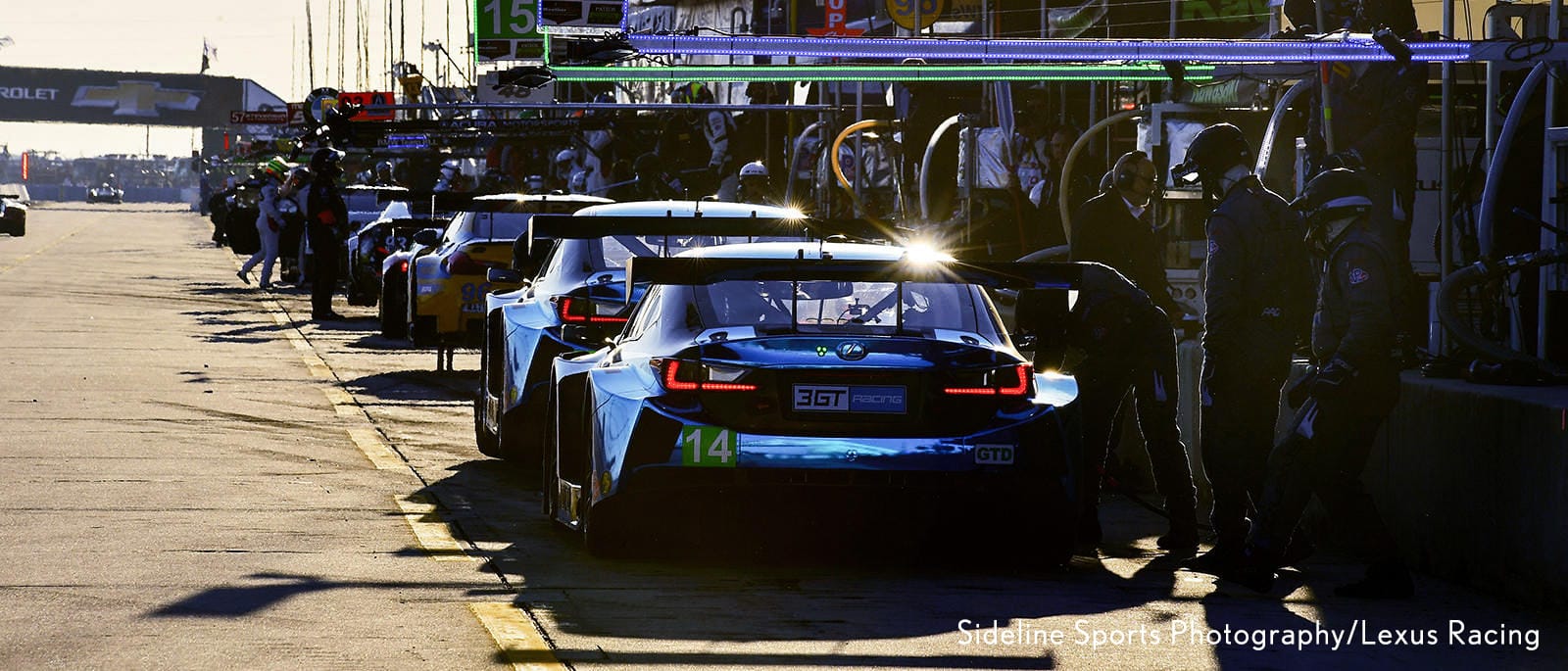
In the 2017 season, two LEXUS RC F GT3 cars were entered in the GT300 class of Japan's SUPER GT series, and two were entered in GTD class of the IMSA series in the U.S. We were fortunate to get comments from two of the accomplished drivers participating in these two series. In this first interview we talked with Yuichi Nakayama who competed in the GT300 class of the SUPER GT series as a driver for the LMcorsa car No. 51. In round 2 of the series at Fuji Speedway, he was part of the team that brought the RC F GT3 its first win of the series. His achievements had him ranked 2nd in the Drivers title race at the end of round 3.
-- Tell us what your impression was the first time you drove the LEXUS RC F GT3 (this season's car).
Yuichi Nakayama: "I drove the RC F GT3 for the first time at Fuji Speedway at the end of January of this year. The first thing I felt was that nothing felt uncomfortable to me about the driving position, the field of vision, the movement of the tires in relation to the degree that I turned the steering wheel, the brake touch, the weight of the accelerator pedal, and the layout of the instruments. Usually when you drive a new car for the first time you will have good feelings in some of the areas, and in others you will feel something uncomfortable about, but it was strange that with the RC F GT3 I didn't have any of those negative feelings. Also, the RC F GT3 has an excellent feeling of rigidity and there was a feeling of assurance when braking from high speeds and cornering in the high-speed curves. As for the engine power delivery, it had a feeling of great deepness to the torque, and there was a feeling that you could gain time just by pressing down on the accelerator.
-- What do you think are the strengths of the RC F GT3 in races?
Nakayama: The RC F GT3 has a high level of performance in the full ranges of braking, cornering and speed on the straights, which makes it a good all-round car. So, its strength is that it will be able to run good times at all types of circuits. And another extremely important thing is that a car be able to run well the full length of the race. This season, our RC F GT3 never once had machine trouble in the course of a race. Including the practice time as well, the fact that we never lost valuable time due to trouble means that we are able to proceed through the set-up work efficiently. Also, thanks to the car's good balance and the fact that the temperature in the car's interior doesn't rise much helps reduce the physical stress on us, which will surely be another strength it will show in endurance racing.
-- How have you felt in terms of your results up until now in this season? You won the second round at Fuji didn't you?
Nakayama: Until now, we have been able to record times that are among the leading times at each circuit. It is a big motivation for the team and the drivers to know that we can always set high goals for ourselves in terms of where we are going to finish. And that has surely contributed to better performance by everyone on the team.Even though we have this easy-to-drive RC F GT3 with its great potential, it is still not easy to beat our opponents' cars. At this point we are still conferring with everyone on the TRD team and working on the various aspects of the machine set-up through trial and error. Still, we were able to find a good direction for set-up work during the tests with the tire makers at Autopolis before the second round at Fuji. And I think that contributed to the good compatibility that led to the win at Fuji Speedway.
-- You are now entering the second half of the season and the title race. What are your goals now?
Nakayama:In this first half of the season we were to come through with a wonderful synergy between the RC F GT3 itself, the support we received from everyone at TRD, the tire people at Bridgestone and everyone on our team. We are among the leaders in the series standings as well, so we have a good chance at winning the title. From here, through the summer, the races will not be easy, I'm sure. So, I want to see all of us, we drivers and the team, work hard to raise our level so that we can win the series title in the new RC F GT3's debut year.
We hope this report has painted a good picture of the efforts and ideals the development team brought to the LEXUS RC F GT3 development project. But this single year will not be the end of the FIA GT3 car development. Through the subsequent upgrades of the LEXUS RC F GT3 and the full-scale model change three years down the line, the development team willspare no effort to make sure they deliver to the world's drivers and teams the kind of uncompromising reliability and trust the Lexus brand dedicates itself to.
